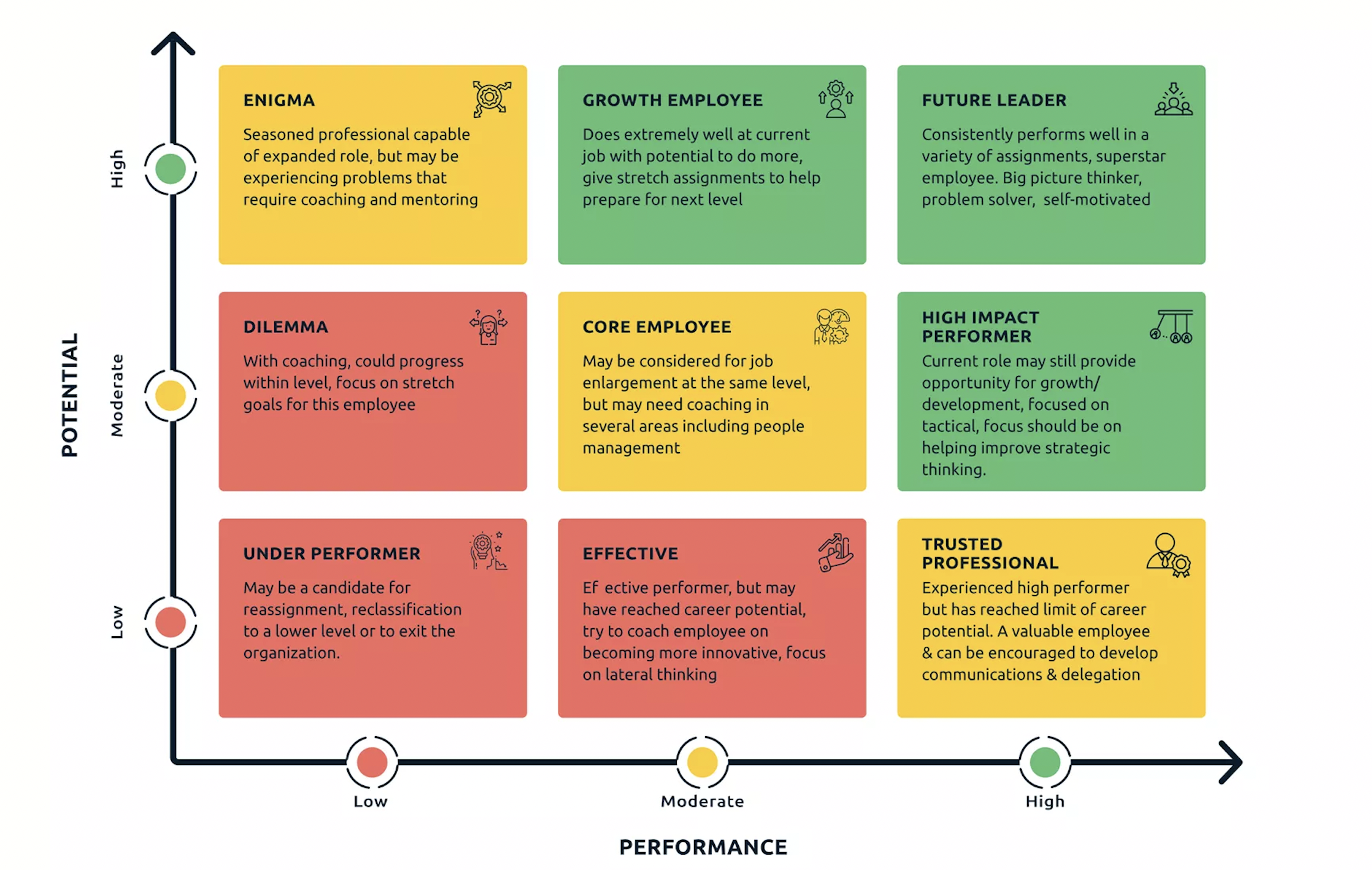Assessing Your Team’s Strengths, Weaknesses, and Motivations
The Benefit of the 9-Box Assessment
Why Understanding Your Team Matters
A high-performing team isn’t just about skill—it’s about balance, motivation, and knowing where each person thrives. Strong managers take the time to understand their team’s strengths, weaknesses, motivations, and career aspirations rather than assuming everyone wants the same trajectory.
The key is recognizing that growth isn’t one-size-fits-all—some team members are hungry for leadership opportunities, while others may be content contributing at their current level.
The reality is that not every employee is constantly striving for upward movement, and that’s okay. Life circumstances, personal priorities, and career satisfaction all play a role in an individual’s motivation at a given time. Some people may temporarily step back due to major life events, while others may prefer to stay in their comfort zone and focus on mastery rather than promotion.
The best managers know that every type of employee has a role to play in building a stable, successful team.
The 9-Box Assessment: A Tool for Clarity
One of the most effective ways to gain a clear picture of your team’s performance and potential is through a 9-box assessment. This framework evaluates team members based on two key dimensions: performance and potential.
By assessing each individual on where they currently stand, managers can make more strategic decisions about assignments, career development, and team balance.
The 9-box model is not just about identifying high performers—it’s about understanding where each person is today and what they need to succeed. Someone with high potential but inconsistent performance may need more structure, while a solid, steady contributor may simply need recognition rather than a push for promotion.
9-Box Talent Assessment: Understanding Team Strengths
This table helps visualize how employees can be categorized based on their performance and potential, and how managers can best support each group.
| Performance | Potential | Employee Type | Characteristics | Management Approach |
|---|---|---|---|---|
| High | High | Future Leaders | Consistently strong performers with a desire and ability to grow into leadership roles. | Provide mentorship, leadership opportunities, and long-term career planning. |
| High | Medium | Key Contributors | Reliable and high-quality performers, may not actively seek leadership but are open to growth. | Challenge them with high-impact work and assess interest in future leadership. |
| High | Low | Steady Performers | Consistently strong contributors who prefer stability over career advancement. | Recognize and retain them through meaningful work, respect their desire for stability. |
| Medium | High | Emerging Talent | Demonstrates strong potential but needs more experience and guidance. | Provide mentorship, targeted skill development, and gradual challenges. |
| Medium | Medium | Reliable Team Players | Solid contributors who may not stand out but play a key role in overall team function. | Maintain engagement through varied assignments and coaching. |
| Medium | Low | Consistent Executors | Do their job well but may not have ambitions for growth or change. | Ensure they feel valued, give stability, and avoid forcing career movement. |
| Low | High | Untapped Potential | Raw talent that lacks current performance but has potential for growth. | Identify barriers, provide structured development plans, and mentorship. |
| Low | Medium | Inconsistent Performers | Show capability but struggle with consistency or motivation. | Help identify roadblocks, provide clearer expectations, and offer targeted support. |
| Low | Low | Misaligned Employees | Struggle to perform and show little interest in growth or improvement. | Provide direct feedback, performance plans, or consider reassignment. |
A Balanced Team: Why Every Box Matters
A common misconception is that only those in the top-right "high performance, high potential" box are valuable. In reality, a successful team includes a mix of steady contributors, rising stars, and leadership-ready employees. Here's why:
High Performers, Low Potential – These employees are rock-solid contributors who may not be seeking promotions but are essential for stability and consistency.
High Potential, Medium Performance – Rising talent that needs coaching and experience to reach their full capability.
Medium Performance, Medium Potential – Often overlooked, but they hold teams together and maintain progress while others are pushing forward.
Low Motivation Today Doesn’t Mean Low Motivation Forever – Life events, burnout, or external pressures can impact ambition. Managers should reassess annually to see where people are.
How a 9-Box Assessment Strengthens Teams
Conducting a 9-box assessment annually helps managers:
Adjust assignments to match strengths and growth areas
Recognize who needs additional mentorship, challenges, or stability
Make informed promotion and succession planning decisions
Balance the team so that no single person carries too much weight
A team where everyone is expected to be a leader creates burnout, while a team without growth opportunities leads to stagnation. The 9-box helps managers create a healthy mix of leaders, contributors, and future talent.
Final Thoughts: Leading with Intentionality
A great manager doesn’t force one-size-fits-all growth—they recognize that different employees bring different value at different times. By using the 9-box assessment to track performance and potential, managers can support their team in a way that aligns with both business goals and individual motivations.
The key is understanding where each person fits, providing the right opportunities, and checking in regularly to see how those needs evolve.
When leaders assign work and develop careers with intention, they build teams that are strong, resilient, and high-performing—without forcing growth that isn’t wanted or needed.

